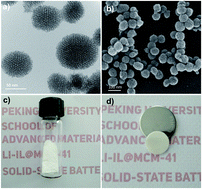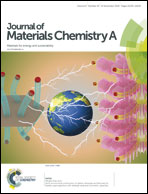An ordered mesoporous silica framework based electrolyte with nanowetted interfaces for solid-state lithium batteries†
Abstract
The practical applications of lithium metal as an anode material are hindered by the uncontrollable growth of lithium dendrites. Herein, an ordered mesoporous silica framework (MCM-41) based solid-state electrolyte (Li-IL@MCM-41 SSE) with nanoconfined ionic liquids is prepared through a post-impregnation method. The as-prepared electrolyte with nanowetted interfaces demonstrates suppression towards lithium dendrites, high thermal stability (up to 350 °C) and excellent electrochemical properties, such as high ionic conductivity (3.98 × 10−4 S cm−1 at 30 °C), a broad electrochemical potential window (up to 5.2 V) and good compatibility with different electroactive materials. The solid-state batteries (SSBs) assembled exhibited excellent cycling performance, delivering capacities of 138 mA h g−1, 127 mA h g−1 and 163 mA h g−1 after 100 cycles at room temperature with LiFePO4, LiCoO2, and LiNi0.8Co0.1Mn0.1O2 cathode materials, respectively. The good battery performance can be ascribed to the effective three-dimensional ion-conducting networks established by the nanowetted interfaces. The aforementioned results exhibit the good prospects of the Li-IL@MCM-41 SSE for application in lithium metal batteries.



 Please wait while we load your content...
Please wait while we load your content...